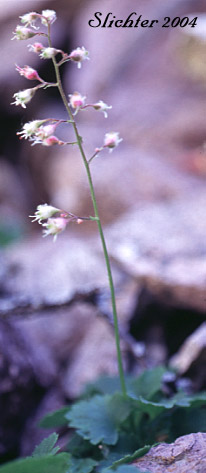 The
photo at right shows the open panicle of red alumroot as seen at Pike Creek, Steens
Mt.
The
photo at right shows the open panicle of red alumroot as seen at Pike Creek, Steens
Mt.
Also known as jack o'the rock, red alumroot. is an attractive perennial wildflower with one to several erect stems from 10-35 cm high arising from a cluster of basal leaves. The herbage of the stems and leaves varies from sparsely glandular hairy to moderately woolly-haired. The overall pubescence seems to increase in plants as one moves further south within their range. The leaves are all basal, although several small bracts may be found on the stems. The leaf blades are suborbicular or broadly ovate with the base of the blade either heart-shaped or abruptly narrowed to the long petiole (See photo below.). The blades are about 1.7-3.5 cm long and about as wide, while the glandular hairy, villous, or occasionally glabrous petioles are 2-8 cm long. The blades are mostly glabrous but may be glandular hairy or villous below, especially below.
The inflorescence is narrow panicle (See photos above and at right.) of spreading to drooping flowers. The pedicels are 1.2-6.5 mm long and are sometimes reddish. The calyx is bell-shaped, conical or urn-shaped. The white, pink or red sepals are obtuse or rounded, unequal in length , measuring 1-2.5 mm long. They are covered with crinkly, white hairs (Just barely visible in the photo at right.). The white petals are linear to filiform, 3.2-5.8 mm long and often becoming deciduous by flowering time. They are attached to the calyx below the sinus between each sepal. The stamens extend beyond the sepals and are as long as the petals. The anthers are about 0.5-1 mm long, orange, yellow or brown in color. The 2 styles are at first short, but extend to 3-5 mm long as the flowers and fruits mature.
Plants flower from late April until September.
Red alumroot would make a suitable rock garden plant for cool, dry climates.
Habitat:
Red alumroot may be found in talus and in the cracks and crevices of rocky cliffs and outcrops. It is found between the elevations of 900-3600 meters within its range.
Red alumroot may be found from southeastern Oregon south to California and east to southern Idaho and southern Colorado and hence south to Nevada, Utah, Arizona and New Mexico.

The photo above shows the basal leaves and inflorescence of red alumroot as seen at Pike Creek, Steens Mt.